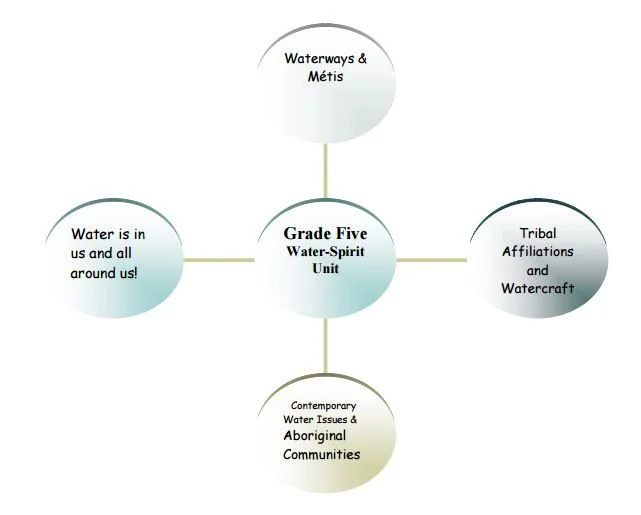Unit Scope and Sequence:
Part 1: Waterways and the Métis Nation
Part 2: Tribal Affiliations and water transportation
Part 3: Contemporary Water issues in Aboriginal Communities
Part 4: Water Spirit; Water is in us and all around us
Where does your water come from?
Importance of Water to First Nation Ceremony and Practice
Additional Activities and Evaluations
Focus Questions:
How were the waterways explored by the Métis and that knowledge passed on to Euro Canadians?
Tribal affiliations and travel by watercraft was an integral part of the exploration of Canada, in what way did First Nations affect water travel in Canada?
How do the past waterways impact the settlement of Canada?
What are the contemporary concerns regarding water in Aboriginal communities?
How have Aboriginal communities and territories been affected by Hydro electricity?
Water is a sacred element to First Nations people, why and in what way?
Unit Summary: The purpose of this unit is to provide students with an opportunity to learn about water and how it is viewed from an Aboriginal perspective. Water is a sacred element, but only one of four sacred elements; the other three are Earth, Wind, and Fire. All life needs water, without water there would be no life. Students will discover that water is in us and all around us. The Grade Five Canadian Curriculum focuses on the First Peoples and the role they had in the creation of the country Canada. This unit is representational of four themes: Métis and the Waterways, Tribal Affiliations and Water Transport, Contemporary Water Issues on First Nation Communities, and Honouring the Water Spirit. This unit can also be adapted to other grade levels.
Subject Area(s): Language Arts, Visual Arts, Drama, Social Studies, Health, Creative Writing, Science
Learning Outcomes: Students will:
Research and map out the main waterways in Canada that the Métis traveled in the 1800s and prior.
Place on a map mural the main waterways of the Canadian Métis.
Be able to identify the Métis as a nation that was instrumental in the fur trade of Canada through their knowledge of waterways.
Research how tribal affiliations and water transport are related.
Construct and design a watercraft based upon the First Nations perspectives (canoe etc.).
Place on a map mural First Nation water transportation devices.
Recognize the historical significance of the waterways and how they relate to contemporary issues in Aboriginal communities.
Understand and reflect upon what water means to Aboriginal peoples of Canada.
Reflect upon the statement “Water is in us and all around us…” and present that theme in a poster.
Organize a water information night for their school and community.
Design posters which promote saving water and reducing water consumption
Student Assessment: Student assessment will be done by participation and through rubrics. The rubrics are located in the appendix at the back of the unit. Students will be able to evaluate their own performance through a student rubric.
Prerequisite Skills:
Able to work individually and in dyads.
Cooperative group work experience
Able to work on the Internet independently and as a group.
Materials and Resources Required for Unit:
Teacher Resources:
The Learning Circle; Classroom Activities on First Nations in Canada: Ages 12-14 https://www.aadnc-aandc.gc.ca/DAM/DAM-INTER-HQ/STAGING/texte-text/ach_lr_ks_lc1214_1331134340172_eng.pdf
Office of the Treaty Commissioner, Treaty Resource Kit http://www.otc.ca
Student Resources:
The Elder’s are Watching. 4th edition, D. Bouchard and R.H. Vickers, 2001 ISBN: 1-55192-110-3
Keepers of the Earth: Native American Stories and Environmental Activities M. Caduta and J. Brudac, 1999, ISBN: 1-894004-38-8
Accommodation Options:
Learning Assistant Students
Include the learning assistant staff in the large group introduction lessons if possible so they can support students if in pull-out programs.
Homogenous grouping for research and group discussions.
Highly-Capable Students
Provide students with an opportunity to gain extra marks for creative writing assignments and drama productions.
Give a bulletin board to develop and update throughout the thematic unit.
Provide additional readings about information within this project.
Provide Internet sites to learn and read more about these issues.
Introduction: The purpose of this unit is to provide students with an opportunity to learn about water and how it is viewed from an Aboriginal perspective. Water is a sacred element. All life needs water, without water there would be no life. Students will discover that water is in us and all around us. This unit is written to fit with the grade five Canadian curricula and the emphasis is on First Peoples with a focus on water. This unit can also be adapted to other grade levels. Indigenous epistemology is holistic in nature and one concept cannot be taught without other concepts being introduced. This unit provides some lessons and they can be expanded upon to provide more information. You could also look at other Operation Water Spirit units to be adapted to fit with this unit.


